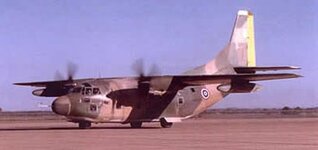-This is way post WW2 but the aircraft was conceived during the war... as a glider. The C-123 Provider had a long, varied and quite successful career filling many quite disparate missions. I'm not a big Wiki fan but he Wiki page on the C-123 is worth a glance if only to look at the variants.
-In the US we don't really like to upgrade weapons systems. After all, the money comes from designing, testing and building the latest beastie with brand new, sometimes theoretical, bells and whistles instead of steadily improving something that we know works. Look at the histories of the A-10 vs. the F-35.
-There are two C-123 variants listed on the Wiki page that I think really should have been considered: the C-123L and the C-123T; both replaced the recip engines with turboprops. The 123L called for GE T-64 engines; I don't know what was proposed for the 123T. My thinking is that the Providers should have been overhauled and fitted with the same family of engine that powered the C-130 Hercules for commonality of maintenance and operation.
-Would this have been like the Basler BT-67 DC-3 conversion that ended up stretching the fuselage something over a meter and increasing cargo volume? I don't know. Certainly changing from R-2800 Double Wasps to whatever 3500+ hp turboprop, in itself a lighter engine, would have increased cargo capacity, speed and probably range and the two turbojet extra engines with special fuel systems and maintenance requirements would go away.
-Why bother? The Army used C-7 Caribous for a while until the Air Force complained and took most of them away. Some Army National Guard (NOT Air National Guard) units kept them: I flew in both California and Puerto Rico NG Caribous in the early '80s. The Army also tried out a few C-8 Buffalos; I saw a couple that belonged to the 11th Air Assault Division (Test) in Vietnam. In the late '80s both the Army and the Air Force realized that an aircraft smaller than the Hercules was needed for tactical airlift support in "austere" environments and experimented with a bunch of small, usually semi-STOL, twin engine cargo birds. The C-27A Spartan, which served from about 1990 to about 1999, had the GE T-64 engines posited for the C-123L. The C-27J, oddly enough, uses engines and internal systems compatable with/derived from C-130s, was standardized in 2007 and the Air Force dumped them in 2012. CASA C-41s, C-23 Sherpas and other SOCOM special purchase, or rental, have been in the inventory.
-Result: we still don't have an in theater fixed wing transport.
-Would it work? Look at the turboprop versions of the DC-3 and look at what the Japanese did to the P-2 Neptune to make the P-2J.
-In the US we don't really like to upgrade weapons systems. After all, the money comes from designing, testing and building the latest beastie with brand new, sometimes theoretical, bells and whistles instead of steadily improving something that we know works. Look at the histories of the A-10 vs. the F-35.
-There are two C-123 variants listed on the Wiki page that I think really should have been considered: the C-123L and the C-123T; both replaced the recip engines with turboprops. The 123L called for GE T-64 engines; I don't know what was proposed for the 123T. My thinking is that the Providers should have been overhauled and fitted with the same family of engine that powered the C-130 Hercules for commonality of maintenance and operation.
-Would this have been like the Basler BT-67 DC-3 conversion that ended up stretching the fuselage something over a meter and increasing cargo volume? I don't know. Certainly changing from R-2800 Double Wasps to whatever 3500+ hp turboprop, in itself a lighter engine, would have increased cargo capacity, speed and probably range and the two turbojet extra engines with special fuel systems and maintenance requirements would go away.
-Why bother? The Army used C-7 Caribous for a while until the Air Force complained and took most of them away. Some Army National Guard (NOT Air National Guard) units kept them: I flew in both California and Puerto Rico NG Caribous in the early '80s. The Army also tried out a few C-8 Buffalos; I saw a couple that belonged to the 11th Air Assault Division (Test) in Vietnam. In the late '80s both the Army and the Air Force realized that an aircraft smaller than the Hercules was needed for tactical airlift support in "austere" environments and experimented with a bunch of small, usually semi-STOL, twin engine cargo birds. The C-27A Spartan, which served from about 1990 to about 1999, had the GE T-64 engines posited for the C-123L. The C-27J, oddly enough, uses engines and internal systems compatable with/derived from C-130s, was standardized in 2007 and the Air Force dumped them in 2012. CASA C-41s, C-23 Sherpas and other SOCOM special purchase, or rental, have been in the inventory.
-Result: we still don't have an in theater fixed wing transport.
-Would it work? Look at the turboprop versions of the DC-3 and look at what the Japanese did to the P-2 Neptune to make the P-2J.



